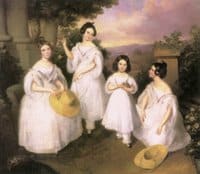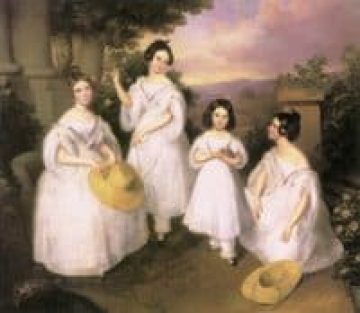
I recently attended an interesting workshop that touched on many aspects of the feminine. One woman presented an idea of sisters as archetypes. She only briefly introduced the idea, asking us whether we identified with little sister, middle sister, or elder sister. This idea has been percolating in my mind. Some brief, unscientific research on my part suggests that there is not much written about this. Here are some of my thoughts, heavily colored by my own personal experience, on the possibilities of these archetypes:
Little Sister
She is wild and carefree. Little sister must fight for her own separate identity. Perhaps she is torn between following her own path or the one forged before her by elder siblings. In my mind she has an untamed energy that can light up a room.
Middle Sister
She is the quiet, often unnoticed observer. She is a peacemaker and mediator, a bridge between her unruly little sister and responsible elder sister. She learns early on that there are many perspectives from which to view life. Much of her wisdom is gleaned by observation. Her energetic field is calm, serene, observant.
Elder Sister
Elder sister carries the hopes and dreams of her mother, and feels a grave sense of responsibility. She is a nurturer. She is wise, and has come to this wisdom by her own experience. Her decisions are measured. She takes charge. She is the representative and spokeswoman of the sisters. I see her energy as being goal-directed and full of intention.
Do you think that these are archetypes in their own right, or are they no different from the generic oldest child, middle child, and youngest child? Which do you identify with? Is it the same as your birth order? What would you add to or change in my definitions? Is there anything to this?






16 Responses
Except for the wisdom part, you’ve nailed me on the Older Sister archetype.
My youngest brother is married to an Older Sister. Her mother was recently injured in a car accident, and she has basically taken charge of the family–not because anyone asked her to, but because she and everyone else just sort of expected it. My brother pouts because he doesn’t understand the wiring that comes with the Older Sister thing. I tried to explain it to him, but he’s used to be the One Taken Care Of (and it plays out in their marriage).
This makes a lot of sense within my family- though two of the roles are reversed. Though I’m the last born, I tend to be more like the Middle Sister and my older sister is more like the Youngest Sister. I think it’s because I was born 6 years after her, so she got quite used to the Youngest role, and I just sorta came up with my own thing. Our oldest sister fits the bill perfectly though.
I definitely think these are archetypes in their own right, just as Elder Middle and Little Brother are all slightly different the normal birth order personalities. A major difference between my oldest sister and oldest brother is my oldest sister has goals not only for herself but for all of her siblings too, especially her sisters. There’s this drive in her to gather us all together and shepherd us that my brother just doesn’t have. It is a good and bad thing all at the same time. 🙂
I don’t have any sisters. Adjust the sexes, though, and your descriptions fit my two brothers and me, according to birth order.
I have one older brother, so i don’t fit into this scheme very well. But at different points of my life, I can see myself in all of these archetypes. When I was younger I was more like the middle sister, quiet and observant. When I got to college the younger sister came out a bit. And now in my late 20s I can see some aspects of the older sister, particularly the spokeswoman, coming out.
My family (six daughters) should be a gold mine of data on sisterhood archetypes. I have to admit that I am, literally and figuratively, an oldest child, in most respects–although I’m not very nurturing and I hate to be in charge of things. When it comes to managing groups, I’m extremely happy to support whoever’s willing to run the show in however she chooses to run it.
Since I am an oldest child, Starfoxy’s comment over at FMH about how her older siblings refuse to take her and her opinions seriously really gave me pause. I feel that once everyone reaches adulthood (and probably well before) it’s vital to flatten out the family hierarchy as much as possible and give everyone a place of respect at the table. That’s my ideal of adult sibling relationships, but I’m not always very good at it.
What I’m gathering from the comments so far is that more people identify more with these as roles than as archetypes.
Like Caroline, I can see bits of each archetype in myself. I’m a textbook oldest child, but lately I’ve identified with what I’ve called the Little Sister archetype, and have wanted to nurture her in myself.
The woman who introduced the idea of these as archetypes related them to the Hindu Goddesses Kali, Lachsmi, and Saraswati. I’m beginning a study of them to see what I can learn.
Eve, I don’t remember what comment you’re talking about, but I’m really flattered you remember it. 🙂
I really struggle with the idea that all the injustice I suffer at the hands of my older siblings is my imagination. I’m certain at least some of it is imagined, but there have been a few instances where I’ve felt incredibly validated by observations others (friends, in-laws, other third parties) have made about our family relationships.
One that has stayed with me for a long long time: at my sister’s wedding the best man (a person none of us had met before) was at our house the night before the sealing. My sister gave me a long list of tasks to complete with her roses and then just sort of ‘ordered’ me to do it. A few minutes later while I was working on the roses the best man came up to me and said “Do they always treat you like that?” I said “like what?” then he explained that he had noticed all my sisters giving me orders, snapping at me, and acting like they were my parents instead of my sisters. He was curious if it was the stress of the wedding or if that’s just how it was. I remember that conversation frequently (especially around the holidays) and remember that it is possible that my siblings are out of line and I’m not just imaginging it.
Anyhow- the point of that whole story is that getting external opinions on your family dynamics can be incredibly helpful.
I think there’s another archetype about sisters, that they truly love each other, understand each other, and can be relied on. The sister as friendly-otherself. I think we measure our sisters by this ideal. When your sister lets you down, you feel cheated.
I know my mother, who never had a sister, desperately wished for one. I think it was because of this ideal.
Starfoxy, thanks for sharing your story. I think you have a good point about getting external viewpoints on family dynamics. You’ve also reminded me, as an older sister, to be more thoughtful about how I treat my younger siblings.
Mother of All,
I couldn’t agree more with you.
I found this site when looking up sister archetypes. I loved this paragraph from it:
The sister archetype
Women’s friendships and women’s circles are not temporary alliances when the Feminine Principle of nurturing, sustaining, and supporting each other bonds women into a circle of sisters. It is the sister archetype in women that makes it possible for women to identify with each other across national, racial, and religious boundaries. It is the ability to feel an empathic connection that makes women able to imagine what it would be like to be on either side of the Israeli-Palestinian divide, or be a woman under the Taliban, or a welfare mother in the United States. It is a point of view that doesn’t see war as something to be won, but as a cause of death and suffering for everyone, especially innocent women and children, but also the young adult sons and daughters who, as soldiers, may die fighting a country that will soon after become an ally.
It looks like the link in my previous comment didn’t work. Here is the site for anyone interested:
http://www.peacexpeace.org/resources/library/papers/shinodabolen.asp
I have a weird mix of fascination with and skepticism about birth order stuff, but I think it’s fun to think about. (Though I never know how the standard models, which usually involve either two or three children, play out when there are more than that.)
Anyway, I’m third of seven, and I think I most closely identify with the middle child, but with a bit of the oldest child mixed in there as well. That’s an interesting idea to think of these as archetypes rather than simply as roles, though. It seems so easy to get stuck in particular family roles (such as in the example Starfoxy and Eve were discussing), and I think it can be somewhat liberating to explore aspects of yourself that don’t necessarily match the identity you have in your family.
amyb, I found the paper again. Your URL got cut off at the end.
peacexpeace.org/resources/library/papers/shinodabolen.asp
interesting organization. I can’t quite go with men screw everything up, but I do like the idea of women communicating with each other and across national boundaries.
Starfoxy,
I’m a middle sister (one sister 2 years older, one sister 2 years younger). I wasn’t exactly thrilled with how I was treated. I always felt like I had to do things “their way” because they always were the leaders. I kept quiet to keep the peace.
The dynamic in my family has changed. But it required pretty much breaking relationships in order to rebuild something better.
I don’t necessarily recommend it.
It was not my choice to fight with my sisters. My sisters chose to not like the fact that I was getting married and rejected me. I had always thought I would be close to my sisters even if we were very different.
There is now love there, and respect. But it has taken my sisters years of slowly rebuilding their relationships with each family member. Both of them have benefitted from therapy.
There is probably still a way to go.
I do feel like they let me down. We should have been able to count on each other. At least now I know that we love each other, respect each other and wish the best for each other. And even though we live far apart it is still wonderful to see them or talk to them. I still feel close to them in a basic way.
We are all in different worlds though. I’m thoroughly in the Mormon, married with kids world, and they are both single, out of the church, one with a career and one with a unfullfilled dream of a career.
I have shared some of my sorrows with them. However, they aren’t the first ones I call, and I know that they don’t call me with their problems either. I am sad about that.
But I have my mother who I am close to, and I have a best friend, so I guess I am lucky. I just always thought I’d have my sisters too.
I’m the oldest of five girls and we all fit the archetypes. We avoid our baby sister like the plague.
My aunt, who is the baby sister, and my daughter, Sarah, are typical baby sisters, as well.
I wish I were the youngest and the baby of the family. They get the sugar cereals.
Lynette, I agree that it can be liberating to explore aspects of oneself that are different from the roles we play out. Exploring these types within myself has helped me try on different roles and different ways of being. It helps me break out of habit energies and find more empathy for people who inhabit different roles or embody different archetypes or styles than I.
mother of all, I didn’t get the “men screw everything up” vibe from that website, but rather that women can make unique contributions to peacemaking. I also like to explore the thought that the sister archetype can be within men as well. It may show up more strongly in most women, but I think men can have it too. Just as women may be able explore brothering or other archetypes within themselves.
I am more like the middle sister despite being younger than my older sister.